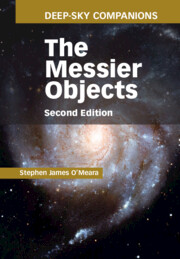Book contents
- Frontmatter
- Contents
- Preface to the second edition
- Preface to the first edition
- Acknowledgments to the first edition
- Chapter 1 A glimpse into the life of Charles Messier
- Chapter 2 How to observe the Messier objects
- Chapter 3 The making of this book
- Chapter 4 The Messier objects
- Chapter 5 Some thoughts on Charles Messier
- Chapter 6 Twenty spectacular non-Messier objects
- Appendix A Objects Messier could not find
- Appendix B Why didn’t Messier include the Double Cluster in his catalogue?
- Appendix C A quick guide to navigating the Coma–Virgo Cluster
- Appendix D Messier marathons
- Image credits
- Alternate name and object index
Appendix D - Messier marathons
Published online by Cambridge University Press: 18 December 2014
- Frontmatter
- Contents
- Preface to the second edition
- Preface to the first edition
- Acknowledgments to the first edition
- Chapter 1 A glimpse into the life of Charles Messier
- Chapter 2 How to observe the Messier objects
- Chapter 3 The making of this book
- Chapter 4 The Messier objects
- Chapter 5 Some thoughts on Charles Messier
- Chapter 6 Twenty spectacular non-Messier objects
- Appendix A Objects Messier could not find
- Appendix B Why didn’t Messier include the Double Cluster in his catalogue?
- Appendix C A quick guide to navigating the Coma–Virgo Cluster
- Appendix D Messier marathons
- Image credits
- Alternate name and object index
Summary
Each spring, amateur astronomers around the world run a marathon – not the grueling 26-mile-long race but a visual race through the night sky to glimpse all 109 Messier objects in a single night. Messier marathons, as they are called, are held during late March and early April, the only time of the year when all the Messier objects are visible between dusk and dawn, and the only time of year when the Sun lies in a region of sky devoid of these celestial treasures. On the first clear, moonless night, marathoners start searching low in the western sky at dusk and then hop from one Messier object to the next until they’ve exhausted all the objects (or themselves) by dawn. Aside from clear skies, success requires a decent knowledge of the stars and constellations, efficient use of a telescope, and the ability to read star charts and confirm the appearance and position of each Messier object. These skills prove critical especially during twilight hours, when inevitably some targets must be found.
To the best of my knowledge, the Messier marathon originated in Spain, when a group of amateur astronomers set out to attempt the task in the 1960s. Several amateur astronomers across the globe independently conceived the notion a decade later. In the March 1979 issue of Sky & Telescope magazine, the late Deep-Sky Wonders columnist Walter Scott Houston described how, in the United States, Tom Hoffelder of Florida began marathoning with amateurs in the mid-1970s, while the Amateur Astronomers of Pittsburgh independently started the activity in 1977. On the West Coast, Donald Machholz, a leading comet discoverer, dreamed up the marathon idea in September 1978. Needless to say, serendipity struck like wildfire, and the activity spread worldwide. Today, astronomy clubs routinely sponsor Messier marathons, as well as variations on the theme, such as binocular marathons, CCD-imaging competitions, and CCD versus visual showdowns. One club even puts on a Messier event in which amateur astronomers compete in a cycling race, stopping occasionally to hunt down Messier objects with portable telescopes!
- Type
- Chapter
- Information
- Deep-Sky Companions: The Messier Objects , pp. 402 - 404Publisher: Cambridge University PressPrint publication year: 2014

